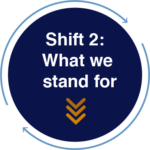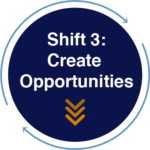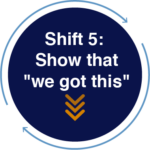
Hope-based communications is een pragmatische strategie, gebaseerd op de geschiedenis, communicatiewetenschappen, neurowetenschappen en cognitieve linguïstiek. Het kan worden toegepast op elke strategie of campagne.
Hoop als strategie voor maatschappelijke verandering
In 2018 hoorde ik voor het eerst Thomas Coombes spreken op het jaarlijkse Bond congres in Londen. Zijn ideeën over hoop als een strategie voor maatschappelijke verandering deden een bruisend enthousiasme opborrelen. Coombes sprak over communicatieveranderingen voor betere narratieven, waardoor mensen meer aangesproken worden om zich in te zetten voor mensenrechten.
Als adverteerders wat dan ook kunnen verkopen (ook dat wat je niet eens dacht nodig te hebben), kunnen wij als mensenrechtenactivisten toch ook creatieve nieuwe manieren vinden om verdraagzaamheid, vriendelijkheid en menselijkheid te promoten. – Thomas Coombes
Een medewerker van Wilde Ganzen was ook aanwezig bij het event en samen besloten we direct dat we Coombes terug wilden zien op het Partos Innovation Festival in oktober om zijn hope-based strategie te delen met Nederlandse en internationale ontwikkelingsorganisaties.
Een alternatief
De hope-based strategie biedt een sterk alternatief voor een in de sector veel gebruikt discours. Geleid door urgentie om problemen aan te pakken zijn boodschappen van ngo’s nogal eens gericht op het aan de kaak stellen van misstanden – en vaak vertaalt dit zich in een negatieve protest boodschap. Want in een wereld met onrechtvaardigheid, geweld, uitsluiting, hongersnood, klimaatcrisis, belastingontduiking, dictaturen en schade aan de natuur, zijn we tegen het schenden van mensenrechten, strijden we tegen racisme en zetten we ons in tegen de klimaatcrisis, stereotyperingen, uitsluiting, of dehumanisering en corruptie.
Als wij tegen alle onverschilligheid in mensen willen raken en mobiliseren, zodat er iets gaat veranderen in deze wereld, dan weten we mensen niet voldoende te bereiken met een oproep over misstanden en problemen. Vaak zien we bij mensen dat als ze problemen als te groot ervaren dat het tot moedeloosheid en apathie leidt. Deze mismatch van een te grote opgave en het gevoel van onvermogen er iets aan te veranderen, leidt ertoe dat mensen afhaken.
Hope-based draait om een alternatieve, praktische strategie: ons eigen verhaal naar voren brengen en een betere wereld schetsen. Het doel visualiseren in plaats van de obstakels benadrukken. Laten zien waar we naar toe willen, en hoe we daar kunnen komen. Als we met succes communiceren hoe dingen zouden moeten zijn, maken we het niet alleen mogelijk, maar ook onvermijdelijk, zoals ook Krizna Gomez ons voorhield in haar talk over ‘foresight’ tijdens het laatste Partos Innovation Festival.
Hoop in een wereld van malaise
Er zijn geluiden van kritiek te horen. Zo stellen sommigen dat hope-based communicatie onterecht een rooskleurig beeld schetst van de wereld, of dat vermomt onder een hoopvolle mantel dezelfde stereotyperingen in stand worden gehouden. Dergelijke kritiek komt voort uit een snelle lezing van de hope-based communicatiestrategie, zoals wanneer men de achterzijde van een boek leest en precies zou weten wat de honderden pagina’s tussen de cover beschrijven. Verrassend is het niet: een lepel hoop als remedie tegen een hardnekkig negatief debat klinkt verdacht eenvoudig. Echter gaat het om een shift in mindset, het afleren van oude gebruiken en nieuwe denkwijzen bouwen – en het opzetten van een andere bril blijkt nu eenmaal niet zo eenvoudig.
Door communicatie te baseren op de waarden waar we voor staan en een visie op de wereld die we willen zien, is op hoop gebaseerde communicatie juist een tegengif voor debatten die voortdurend in het voordeel van tegenstanders lijken te zijn. En dat is precies hoe we acties kunnen ontwikkelen die de agenda bepalen, in plaats van voortdurend te reageren op externe gebeurtenissen. De kritische blik blijft onveranderlijk, stereotyperingen worden onder de loep genomen en onconventionele gesprekken worden aangegaan. Alleen dan met in ons achterhoofd altijd het doel dat ons de weg wijst naar een betere wereld.
Vieren in vijf stappen
Een op hoop gebaseerde communicatiestrategie gaat gepaard met vijf fundamentele verschuivingen in de manier waarop we over ontwikkelingssamenwerking, mensenrechten en duurzame ontwikkeling praten. De kern: vertel de mensen niet alleen waar je tegen bent, vertel ze ook waar je voor staat. We moeten even goed worden in het vieren van de dingen die we in de wereld willen zien als in het bekritiseren van de dingen die we willen stoppen, want op die manier bieden we perspectief.





De milieubeweging maakte deze verschuivingen toen zij zich realiseerde dat verhalen over naderend onheil tot moedeloosheid leidden in plaats van tot urgentie. Een oproep tot climate justice maakt dat mensen kunnen bijdragen. De LGBT-beweging verschoof van campagnes tegen discriminatie naar campagnes gebaseerd op gedeelde waarden, door zich te richten op één van de vele mogelijke beleidsoplossingen: het gelijke huwelijk, een oproep die geworteld is in liefde en medeleven en die iedereen kan onderschrijven.
Na het Partos Innovation Festival, waar Coombes inderdaad zijn verhaal uit de doeken deed, en latere proeftuinen waar we verder deze strategie verkenden met leden, hebben veel organisaties hope-based communicatie omarmd als een stap voorwaarts. Een stap om de missie, visie en doelen van ontwikkelingsorganisaties beter te communiceren en mensen daarin te betrekken. Concord noemt het solution-based communications: samen werken aan een inclusieve, eerlijke en duurzame wereld waarin iedereen meetelt en mee kan doen.
Een hoopvolle toekomst
Waar urgentie & doemscenario-communicatie mensen moedeloos en passief maakt, biedt hope-based communicatie een alternatief waar mensen kracht uit kunnen putten om tot actie over te gaan. Uiteraard betekent dit niet dat de wereld rozengeur en maneschijn is en we met een rugzak vol met hoop over trauma’s en stelselmatige uitsluiting heenstappen richting een geweldige toekomst. Hope-based communicatie is ook geen excuus om stereotyperingen te romantiseren. Daarom combineert Partos de hope-based strategie met inclusieve communicatie, en onderzoeken we continu op welke manier hope-based onze missie versterkt zonder urgente onderwerpen zoals neokolonialisme te verhullen.
Zo organiseert Partos proeftuinen, leersessies waar we samen met andere organisaties bruggen slaan tussen theorie en praktijk, geleerde lessen delen en struikelblokken bespreken. In dezelfde lijn brengen we Nederlandse en internationale organisaties samen om dekolonisering aan te kaarten. De stemmen van organisaties buiten Nederland zijn cruciaal om de glazen van onze bril te vervangen en discrepanties te zien waar we eerder geen oog voor hadden. Ook het Innovation Festival in oktober 2021 stond in het teken van inclusie en machtsstructuren – kapstoktermen die we samen met internationale experts ontleedden. Zo gaven Ishita Dutta, Rosebella Nyumba en Dumiso Gatsha nieuwe perspectieven, pakten Krizna Gomez, Jurjen van den Bergh, Kiza Magendane en Maryia Sadouskaya-Komlach framing aan en begeleidde Wouter Oomen (Expertise Centre Humanitarian Communication) een sessie over Shifts in Communication waarbij de ethische kant van de communicatiepraktijk ook aan bod kwam.
Hope-based communicatie is geen mantel om onder te verschuilen. Hoop betekent namelijk niet dat we gevrijwaard zijn van ethisch en inclusief handelen. Maar hoop roept wel op tot samenwerking, verbondenheid en solidariteit met mensen en globale opgaven die we hard nodig hebben in een wereld waar helaas zoveel problemen spelen. Ontwikkelingssamenwerking staat namelijk voor internationale gelijkwaardige relaties en samenwerking zonder westers-veto. Voorbeelden zijn er genoeg; de ongelijke verdeling van COVID-vaccins, de omgang met migranten en vluchtelingen, internationaal maatschappelijk verantwoord ondernemen (IMVO), wetgeving die niet schadelijk is voor landen die het onderspit delven, beleidscoherentie, onze voetafdruk, belastingontduiking in een neoliberaal systeem, noem het maar op.
Juist daarom is een hoopvol toekomstbeeld cruciaal, zodat we eraan herinnerd worden waarom we doen wat we doen. Zodat we met duizenden meelopen in een klimaatmars en gerechtigheid eisen. Zodat we petities ondertekenen om patent op COVID-vaccinaties op te heffen. Zodat we het systeem blijven bevragen. Zodat we samen bouwen aan betrokkenheid en verbinding, aan inclusieve en duurzame ontwikkeling wereldwijd. Door meer en beter samen te werken, kan er maatschappelijke druk ontstaan op besluitvormers, om zo beleid en veranderingen ten goede te keren.
Chili als voorbeeld dat het werkt
Een persoonlijke noot, ter afsluiting, in 2019 merkte ik van de zijlijn (getrouwd met een Chileense man en nauw verbonden met de Chileense diaspora) hoe hope-based communiceren een vogelvlucht kan nemen en kan bijdragen aan eenheid en solidariteit. Na een verhoging van een metro kaartje van 30 cent gingen scholieren in Santiago in protest. En al gauw liep dit uit op een breed gedragen oproep naar een waardiger bestaan. Miljoenen mensen kwamen samen in de straten van Santiago onder het motto ‘No es por 30 pesos, es por dignidad’ - het gaat niet om 30 pesos, maar om een waardig bestaan.
Na zoveel jaren onrechtvaardigheid, misstanden, neoliberalisme en extreme ongelijkwaardigheid, verenigden miljoenen burgers zich in de publieke ruimte. Zij konden zich niet vinden in de polariserende boodschap van links of rechts, maar wel in een boodschap van waardigheid. Nu, twee jaar later, zit de Mapuche activiste en feministe Elisa Loncon als voorzitter aan tafel om de grondwet uit de dictatuur van Pinochet te veranderen. Ook won Gabriel Boric, een voormalige studentenactivist van 35 lentes jong, het presidentschap. De jongste president met de meeste stemmen ooit gekozen. De sociale protesten hebben geleid tot politieke en maatschappelijke veranderingen die 40 jaar lang als ondenkbaar werden gezien. Hoe krachtig is de stap voorwaarts, dat een vrouw in de Mapuche taal de leiding heeft in het proces naar een meer inclusieve grondwet? Voor mij persoonlijk geeft dat veel hoop. Samen werkt.
La esperanza le ganó al miedo en Chile
De hoop won van de angst, een veel gebruikte slogan die in Chili werd gebruikt tijdens de sociale protesten.
Sera Koolmees
Afbeelding: Boric & Loncon; iberoamericasocial.com
Communication Blog | A hopeful future
Hope-based communications is a pragmatic strategy based on history, communication sciences, neuroscience and cognitive linguistics. It can be applied to any strategy or campaign.
Hope as a strategy for social change
It was back in 2018 when I first heard Thomas Coombes speak at the annual Bond conference in London. His ideas on hope as a strategy for social change sparked a bubbling enthusiasm. Coombes talked about communication changes for better narratives, making people more engaged in human rights.
Surely, if advertisers can sell whatever (even that which you didn’t even think you needed), we human rights activists can find creative new ways to promote tolerance, kindness and humanity. – Thomas Coombes
A staff member from Wilde Ganzen also attended the event and together we decided that we wanted to invite Coombes as a speaker at the Partos Innovation Festival in October to share his hope-based strategy with Dutch and international development organisations.
An alternative
The hope-based strategy offers a strong alternative to a discourse commonly used in the development cooperation sector. Guided by the urgency to address problems, NGO’s messages are quite often focused on denouncing wrongs – prone to the risk of becoming a negative protest message. After all, in a world of injustice, violence, exclusion, famine, climate crisis, tax evasion, dictatorships and damage to nature, we oppose human rights violations, fight racism, and push back against the climate crisis, stereotyping, exclusion, or dehumanization and corruption.
If our aim were to mobilise people and create a change in this world, business as usual might not be the path we want to continue walking – as a very significant fight to fight is the fight against indifference. By focusing on wrongs, problems can be perceived as too big, leading to despondency and apathy. The mismatch between too big of a task and the feeling of inability to change it leads people to drop out.
The hope-based strategy revolves around an alternative, practical strategy: bringing our own story forward and outlining a better world. Visualizing the goal rather than highlighting the obstacles. Showing where we want to go and how we can get there. When we successfully communicate how things should be, we make it not only possible but inevitable, as Krizna Gomez also reminded us in her talk on foresight at the 2021 Partos Innovation Festival.
Hope in a world of malaise
There are sounds of criticism. Some argue that hope-based communication unfairly paints a rosy picture of the world, or that disguised under a cloak of hope existing stereotypes are perpetuated. Such criticism comes from a quick read of the hope-based communication strategy – as if one were reading the back cover of a book and would know exactly what the hundreds of pages between the cover describe. It’s not surprising: a spoonful of hope as a cure for a persistent negative debate sounds suspiciously simple. However, it is about a shift in mindset, unlearning old habits and building new ways of thinking. Putting on a different pair of glasses is easier said than done.
By basing communication on the values we stand for and a vision of the world we want to see, hope-based communication is precisely an antidote to debates that constantly seem to favor opponents. And that is exactly how we can develop actions that set the agenda, rather than constantly reacting to external events. Critical analysis remains unchanging, stereotypes are scrutinized and unconventional conversations are taking place. What changes is that in the back of our minds, there’s always an objective: the goal that shows us the way to a better world.
Celebrating in five steps
A hope-based communication strategy involves five fundamental shifts in the way we talk about development cooperation, human rights and sustainable development. At its core: don’t just tell people what you’re against, tell them what you stand for. We need to become as good at celebrating the things we want to see in the world as we are at criticizing the things we want to stop because that’s how we offer perspective.





The environmental movement made these shifts when it realized that stories of impending doom and ticking clocks led to despondency rather than urgency. A call for climate justice makes people want to contribute. The LGBT movement shifted from campaigns against discrimination to campaigns based on shared values by focusing on one of many possible policy solutions: equal marriage, a call rooted in love and compassion that anyone can endorse.
Since the Partos Innovation Festival, where Coombes did present his story, and subsequent learning labs where we further explored this strategy with members, many organisations have embraced hope-based communication as a step forward. A step to better communicate the mission, vision and goals of development organisations and a way to engage people. Concord calls it solution-based communications: working together to create an inclusive, fair and sustainable world where everyone counts and can participate.
A hopeful future
Where urgency & doomsday communication makes people despondent and passive, hope-based communication offers an alternative from which people can draw strength to take action. Of course, this does not mean that the world is a rosy place and packed with a backpack full of hope we’ll walk all over trauma and systematic exclusion towards a great future. Neither is hope-based communication an excuse to romanticise stereotypes. That’s why Partos combines the hope-based strategy with inclusive communication, and why we continually explore ways in which hope-based strengthens our mission without obscuring pressing issues like neocolonialism.
Partos organises labs ([NL] proeftuinen): learning sessions where we work with other organisations to build bridges between theory and practice, share lessons learnt and discuss stumbling blocks. Similarly, we bring Dutch and international organizations together to address decolonisation. The voices of organisations outside the Netherlands are crucial in replacing the lenses of our glasses and to be able to see discrepancies that we were previously unaware of. That’s why the Innovation Festival in October 2021 was dedicated to inclusion and power structures – capstone terms that we dissected together with international experts. Ishita Dutta, Rosebella Nyumba and Dumiso Gatsha provided new perspectives. Krizna Gomez, Jurjen van den Bergh, Kiza Magendane and Maryia Sadouskaya-Komlach tackled framing. Wouter Oomen (Expertise Centre Humanitarian Communication) supervised a session on shifts in communication covering the ethical side of communication.
Hope-based communication is not a cloak to hide under. Indeed, hope does not mean that we are immune from acting ethically and inclusively. But hope does call for cooperation, connection and solidarity with people and global tasks that we need in a world where, unfortunately, there are still so many problems. Development cooperation stands for international equal relations and cooperation without a Western veto. Examples abound; the unequal distribution of COVID vaccines, dealing with migrants and refugees, international corporate social responsibility (CSR), legislation that does not harm countries that lose out, policy coherence, our footprint, tax evasion in a neoliberal system, you name it.
This is precisely why a hopeful vision of the future is crucial to remind us why we do what we do. So that we walk with thousands in a climate march and demand justice. So that we sign petitions to lift patents on COVID vaccinations. So that we continue to question the system. So that we build together for engagement and connection, for inclusive and sustainable development worldwide. By working more and better together, societal pressure can result in decision-makers changing policies – change for the better.
Chile as an example that it works
A personal note, in conclusion, in 2019 I noticed from the sidelines (married to a Chilean man and closely associated with the Chilean diaspora) how hope-based communication can take a bird’s eye view and contribute to unity and solidarity. After a 30-cent increase for subway tickets, school youth in Santiago went into protest. In the blink of an eye it turned into a broad-based call for a more dignified existence. Millions of people came together in the streets of Santiago under the motto ‘No es por 30 pesos, es por dignidad’ – it’s not about 30 pesos, but about dignity.
After so many years of injustice, abuses, neoliberalism and extreme inequality, millions of citizens united in the public sphere. They could not agree with polarising messages of either left or right, but found themselves in a message of dignity and hope. Now, two years later, Mapuche activist and feminist Elisa Loncon is at the table as chairwoman to change the constitution from Pinochet’s dictatorship. Also, Gabriel Boric, a former student activist 35 springs young, won the presidency. The youngest president with the most votes ever elected. The social protests led to political and social changes that had been considered unthinkable for 40 years. How powerful is the step forward, when a woman in the Mapuche language is leading the process towards a more inclusive constitution? For me personally, that gives me great hope. Together works.
La esperanza le ganó al miedo en Chile
Hope won over fear, a common slogan used in Chile during the social protests.
Sera Koolmees
Image: Boric & Loncon; iberoamericasocial.com